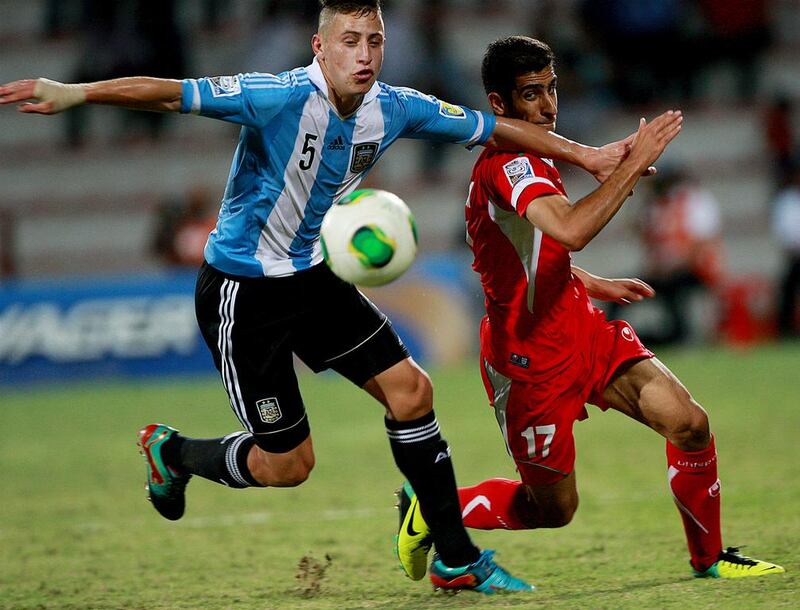DUBAI // For the last three decades, it has been Argentinian football’s, if not world football’s, holy grail. Or its poisoned chalice, depending how you look at it.
Finding the “next Maradona” is a national pastime west of the River Plate. To varying degrees, some have coped relatively well with the burden of being compared to arguably the greatest player of all time – players such as Ariel Ortega, Pablo Aimar, Juan Roman Riquelme, Javier Saviola, Carlos Tevez, Sergio Aguero.
Others, like Andres D’Alessandro and Diego Buonanotte, less so.
But no one has come close. Until that is, a diminutive, gifted imp who went by the nickname of “the flea”, and who had never even played for an Argentinian club, burst onto the scene in 2006.
Today, it is the “new Messi” that Argentina seeks.
Those present at Rashid Stadium yesterday for Argentina’s clash against Iran had a first glimpse the boy most likely to inherit the mantle. The Fifa U17 World Cup match ended in 1-1 draw, and one man, or boy, had the eyes of the media on him.
We had come to eye the new golden boy of Argentinian football, Sebastian Driussi. The lad from River Plate shot to fame earlier this year with a sensational overhead goal for Argentina against Uruguay. The way he took his first-half goal yesterday, and his movement and maturity in general, suggests his time will come.
But there was no shortage of small men with magical feet at Rashid Stadium. And not all were were in blue-and-white stripes, either.
Nor was Driussi, wearing number nine, the first Argentinian to shine. In fact, it was their number 11, left-winger Marcos Astina, who instantly singled himself out as the most dazzling of the Argentinian players.
Argentina had been stunned in the first minute of the match when Iranian defender Mostafa Hashemi unleashed a viciously dipping, unstoppable volley past Augusto Batalla.
When Argentina equalised, it came, inevitably, from their two front players. Astina with a cutback from the right having ghosted past the left-back, and Driussi with a superb first-time finish that Gabriel Batistuta would have been proud of.
The match would fail to reach those heights again.
On Friday, the European Champions Russia lost their opening match to Japan. And earlier yesterday, World Cup holders Mexico were humiliated 6-1 by African Champions Nigeria. Things were hardly going to plan for the South American champions either.
Iran were easily the better of the two teams in the first half, and in winger Ali Hazemi and striker Amir Mazloum, had two players who eclipsed the contributions of Driussi and Astina.
Not everyone had come seeking the next Messi, in any case. Iran’s wonderful, noisy fans sang their hearts out throughout, and many of them were women. Some wore head scarfs, others did not; all simply enjoying the spectacle of a football match, something they are forbidden from attending in their home country.
Mazloum, which translates to mean “hard done by” in Arabic, could have stolen the headlines when he volleyed high and wide at the end of the first half, when a more controlled finish would surely have given Iran an interval lead.
When the match’s first Messi-esque moment arrived early in the second half, it came from the team in red, when substitute Al Golizadeh slalomed through the Argentinian defense before shooting hopelessly over the bar.
A minute later, Driussi returned the compliment, slicing a somewhat more awkward chance over after Amini had parried a shot into his path.
The match had settled into a pattern. Argentina attacking down their right wing, Iran their left. Sadly, the finishing, apart from the two superb goals, of course, was lacking.
The match need a moment of magic, and the two number nines remained the most likely to provide it. Would it come from Driussi? Or Mazloum? Neither, it turned out.
Argentina had the better of the second half, but in truth, Driussi spent evening on the periphery of the action. The touch, the vision and the passing were there for all to see. But having seen his teammate Lucio Compagnucci sent off on 81 minutes, could he step up when his team needed him most?
It was perhaps too much to ask with the eyes of the world, not to mention a few scouts, on him. His teammates did not exactly offer chances on a plate, either.
At the other end, the Iranian number nine’s hit-and-miss decision-making had his coach, perhaps harshly, screaming on the touchline. Mazloum indeed.
It is easy to forget that the players are only 17, and football, after all, remains a team game. In that sense, both players, and teams, will be pleased with a point apiece.
The new Messi? It is obscenely early to even suggest such unrealistic tags. We should just let Driussi, Astina and Mazloum – plus the rest of us, for that matter – enjoy the ride.
Still, should Driussi score a solo goal against Austria on Tuesday, do not be surprised if Messi’s name crops up once or twice in the morning papers.
We cannot help ourselves.
akhaled@thenational.ae
@ For more FIFA UNDER 17 WORLD CUP news visit our topic page
Follow us on twitter at @SprtNationalUAE
Download the World Cup wall chart





